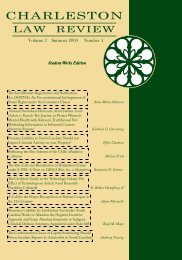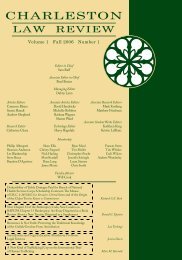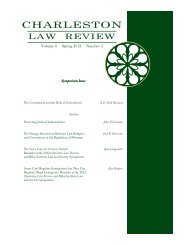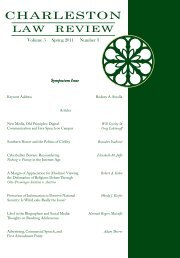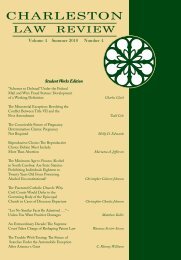Volume 5 Winter 2011 Number 2 - Charleston Law Review
Volume 5 Winter 2011 Number 2 - Charleston Law Review
Volume 5 Winter 2011 Number 2 - Charleston Law Review
You also want an ePaper? Increase the reach of your titles
YUMPU automatically turns print PDFs into web optimized ePapers that Google loves.
<strong>2011</strong>] Errors in Judgmentwhat the general unsecured creditors are entitled to. 232The troubling aspect of Schwab is the way the Courtdevalues actual notice. If all that was present in Schwab werethe facts and figures on Schedules B and C, then it would beunderstandable for the Court to assert that the trustee couldhave missed the nuanced implication that the amounts onSchedule B being equal to the amount on Schedule C meant thatthe debtor was taking an exemption in the entire property.However, the Court ignores the most potent factors that shouldhave led the trustee to know that Reilly was claiming anexemption in all of the property. 233 First, an appraiser told thetrustee that the property was undervalued. 234 Secondly, andmost importantly, the debtor told the trustee that she wasclaiming all of the property as exempt. 235 Failure of the Court toaddress the facts of actual notice to the trustee of Reilly’sintention to claim the entire value of the equipment coupled withthe trustee’s actual knowledge that the property may beundervalued on Schedule B seems almost surreal. When thetrustee informed Reilly at the meeting of creditors that he wasgoing to ask the bankruptcy court to allow him to auction theproperty, Reilly protested vehemently and stated unequivocallythat she wanted to exempt the entire value of the equipment. 236These facts are discussed in the dissent, 237 but the majoritytreats these most salient facts as the elephant in the room. Themajority mentions seemingly reluctantly the fact that the trusteeknew of the appraisal but then does not give the total picture. 238The majority says that the trustee knew about the appraisalbefore the end of the thirty-day period for objections, 239 but infact he knew about the appraisal before the thirty-day periodbegan. 240 Instead of broadening the scope of actual notice, the232. Id. at ___, 130 S. Ct. at 2661–62.233. Id. at ___, 130 S. Ct. at 2671–73 (Ginsburg, J., dissenting).234. Id. at ___, 130 S. Ct. at 2671.235. Id. at ___, 130 S. Ct. at 2672.236. Id. at ___, 130 S. Ct. at 2671 n.3.237. See id. at ___, 130 S. Ct. at 2671–72.238. Id. at ___, 130 S. Ct at 2658 (majority opinion).239. See id. at ___, 130 S. Ct. at 2658 n.2.240. See id. at ___, 130 S. Ct. at 2671 n.3 (Ginsburg, J., dissenting).225



